Jisoo Jeong
ODG: Occupancy Prediction Using Dual Gaussians
Jun 12, 2025Abstract:Occupancy prediction infers fine-grained 3D geometry and semantics from camera images of the surrounding environment, making it a critical perception task for autonomous driving. Existing methods either adopt dense grids as scene representation, which is difficult to scale to high resolution, or learn the entire scene using a single set of sparse queries, which is insufficient to handle the various object characteristics. In this paper, we present ODG, a hierarchical dual sparse Gaussian representation to effectively capture complex scene dynamics. Building upon the observation that driving scenes can be universally decomposed into static and dynamic counterparts, we define dual Gaussian queries to better model the diverse scene objects. We utilize a hierarchical Gaussian transformer to predict the occupied voxel centers and semantic classes along with the Gaussian parameters. Leveraging the real-time rendering capability of 3D Gaussian Splatting, we also impose rendering supervision with available depth and semantic map annotations injecting pixel-level alignment to boost occupancy learning. Extensive experiments on the Occ3D-nuScenes and Occ3D-Waymo benchmarks demonstrate our proposed method sets new state-of-the-art results while maintaining low inference cost.
BePo: Leveraging Birds Eye View and Sparse Points for Efficient and Accurate 3D Occupancy Prediction
Jun 08, 2025Abstract:3D occupancy provides fine-grained 3D geometry and semantics for scene understanding which is critical for autonomous driving. Most existing methods, however, carry high compute costs, requiring dense 3D feature volume and cross-attention to effectively aggregate information. More recent works have adopted Bird's Eye View (BEV) or sparse points as scene representation with much reduced cost, but still suffer from their respective shortcomings. More concretely, BEV struggles with small objects that often experience significant information loss after being projected to the ground plane. On the other hand, points can flexibly model little objects in 3D, but is inefficient at capturing flat surfaces or large objects. To address these challenges, in this paper, we present a novel 3D occupancy prediction approach, BePo, which combines BEV and sparse points based representations. We propose a dual-branch design: a query-based sparse points branch and a BEV branch. The 3D information learned in the sparse points branch is shared with the BEV stream via cross-attention, which enriches the weakened signals of difficult objects on the BEV plane. The outputs of both branches are finally fused to generate predicted 3D occupancy. We conduct extensive experiments on the Occ3D-nuScenes and Occ3D-Waymo benchmarks that demonstrate the superiority of our proposed BePo. Moreover, BePo also delivers competitive inference speed when compared to the latest efficient approaches.
SciFlow: Empowering Lightweight Optical Flow Models with Self-Cleaning Iterations
Apr 11, 2024



Abstract:Optical flow estimation is crucial to a variety of vision tasks. Despite substantial recent advancements, achieving real-time on-device optical flow estimation remains a complex challenge. First, an optical flow model must be sufficiently lightweight to meet computation and memory constraints to ensure real-time performance on devices. Second, the necessity for real-time on-device operation imposes constraints that weaken the model's capacity to adequately handle ambiguities in flow estimation, thereby intensifying the difficulty of preserving flow accuracy. This paper introduces two synergistic techniques, Self-Cleaning Iteration (SCI) and Regression Focal Loss (RFL), designed to enhance the capabilities of optical flow models, with a focus on addressing optical flow regression ambiguities. These techniques prove particularly effective in mitigating error propagation, a prevalent issue in optical flow models that employ iterative refinement. Notably, these techniques add negligible to zero overhead in model parameters and inference latency, thereby preserving real-time on-device efficiency. The effectiveness of our proposed SCI and RFL techniques, collectively referred to as SciFlow for brevity, is demonstrated across two distinct lightweight optical flow model architectures in our experiments. Remarkably, SciFlow enables substantial reduction in error metrics (EPE and Fl-all) over the baseline models by up to 6.3% and 10.5% for in-domain scenarios and by up to 6.2% and 13.5% for cross-domain scenarios on the Sintel and KITTI 2015 datasets, respectively.
OCAI: Improving Optical Flow Estimation by Occlusion and Consistency Aware Interpolation
Mar 26, 2024



Abstract:The scarcity of ground-truth labels poses one major challenge in developing optical flow estimation models that are both generalizable and robust. While current methods rely on data augmentation, they have yet to fully exploit the rich information available in labeled video sequences. We propose OCAI, a method that supports robust frame interpolation by generating intermediate video frames alongside optical flows in between. Utilizing a forward warping approach, OCAI employs occlusion awareness to resolve ambiguities in pixel values and fills in missing values by leveraging the forward-backward consistency of optical flows. Additionally, we introduce a teacher-student style semi-supervised learning method on top of the interpolated frames. Using a pair of unlabeled frames and the teacher model's predicted optical flow, we generate interpolated frames and flows to train a student model. The teacher's weights are maintained using Exponential Moving Averaging of the student. Our evaluations demonstrate perceptually superior interpolation quality and enhanced optical flow accuracy on established benchmarks such as Sintel and KITTI.
FutureDepth: Learning to Predict the Future Improves Video Depth Estimation
Mar 19, 2024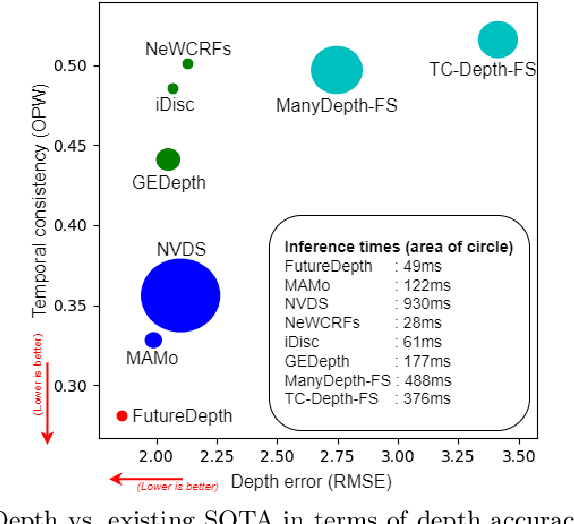
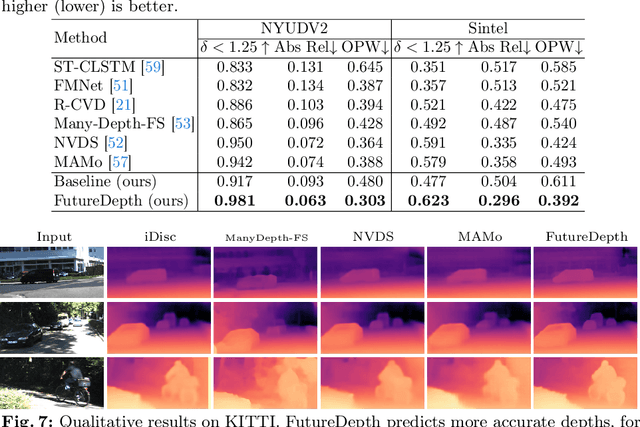

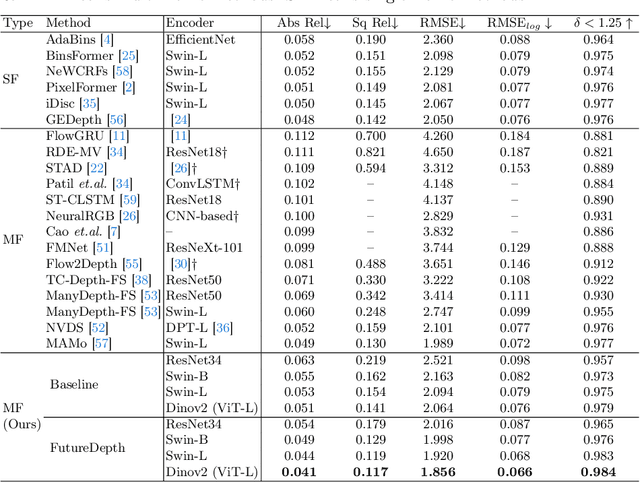
Abstract:In this paper, we propose a novel video depth estimation approach, FutureDepth, which enables the model to implicitly leverage multi-frame and motion cues to improve depth estimation by making it learn to predict the future at training. More specifically, we propose a future prediction network, F-Net, which takes the features of multiple consecutive frames and is trained to predict multi-frame features one time step ahead iteratively. In this way, F-Net learns the underlying motion and correspondence information, and we incorporate its features into the depth decoding process. Additionally, to enrich the learning of multiframe correspondence cues, we further leverage a reconstruction network, R-Net, which is trained via adaptively masked auto-encoding of multiframe feature volumes. At inference time, both F-Net and R-Net are used to produce queries to work with the depth decoder, as well as a final refinement network. Through extensive experiments on several benchmarks, i.e., NYUDv2, KITTI, DDAD, and Sintel, which cover indoor, driving, and open-domain scenarios, we show that FutureDepth significantly improves upon baseline models, outperforms existing video depth estimation methods, and sets new state-of-the-art (SOTA) accuracy. Furthermore, FutureDepth is more efficient than existing SOTA video depth estimation models and has similar latencies when comparing to monocular models
MAMo: Leveraging Memory and Attention for Monocular Video Depth Estimation
Jul 26, 2023Abstract:We propose MAMo, a novel memory and attention frame-work for monocular video depth estimation. MAMo can augment and improve any single-image depth estimation networks into video depth estimation models, enabling them to take advantage of the temporal information to predict more accurate depth. In MAMo, we augment model with memory which aids the depth prediction as the model streams through the video. Specifically, the memory stores learned visual and displacement tokens of the previous time instances. This allows the depth network to cross-reference relevant features from the past when predicting depth on the current frame. We introduce a novel scheme to continuously update the memory, optimizing it to keep tokens that correspond with both the past and the present visual information. We adopt attention-based approach to process memory features where we first learn the spatio-temporal relation among the resultant visual and displacement memory tokens using self-attention module. Further, the output features of self-attention are aggregated with the current visual features through cross-attention. The cross-attended features are finally given to a decoder to predict depth on the current frame. Through extensive experiments on several benchmarks, including KITTI, NYU-Depth V2, and DDAD, we show that MAMo consistently improves monocular depth estimation networks and sets new state-of-the-art (SOTA) accuracy. Notably, our MAMo video depth estimation provides higher accuracy with lower latency, when omparing to SOTA cost-volume-based video depth models.
DIFT: Dynamic Iterative Field Transforms for Memory Efficient Optical Flow
Jun 09, 2023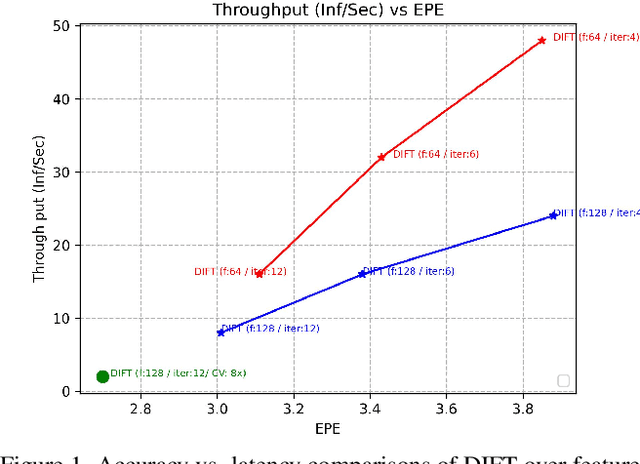

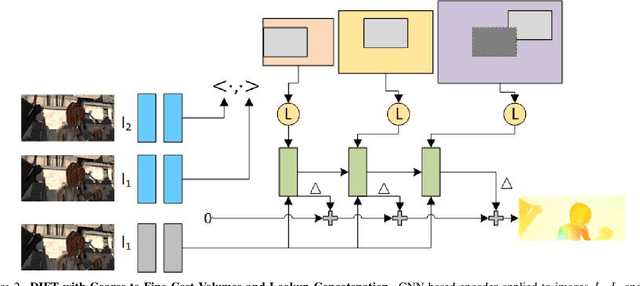

Abstract:Recent advancements in neural network-based optical flow estimation often come with prohibitively high computational and memory requirements, presenting challenges in their model adaptation for mobile and low-power use cases. In this paper, we introduce a lightweight low-latency and memory-efficient model, Dynamic Iterative Field Transforms (DIFT), for optical flow estimation feasible for edge applications such as mobile, XR, micro UAVs, robotics and cameras. DIFT follows an iterative refinement framework leveraging variable resolution of cost volumes for correspondence estimation. We propose a memory efficient solution for cost volume processing to reduce peak memory. Also, we present a novel dynamic coarse-to-fine cost volume processing during various stages of refinement to avoid multiple levels of cost volumes. We demonstrate first real-time cost-volume based optical flow DL architecture on Snapdragon 8 Gen 1 HTP efficient mobile AI accelerator with 32 inf/sec and 5.89 EPE (endpoint error) on KITTI with manageable accuracy-performance tradeoffs.
DistractFlow: Improving Optical Flow Estimation via Realistic Distractions and Pseudo-Labeling
Mar 24, 2023



Abstract:We propose a novel data augmentation approach, DistractFlow, for training optical flow estimation models by introducing realistic distractions to the input frames. Based on a mixing ratio, we combine one of the frames in the pair with a distractor image depicting a similar domain, which allows for inducing visual perturbations congruent with natural objects and scenes. We refer to such pairs as distracted pairs. Our intuition is that using semantically meaningful distractors enables the model to learn related variations and attain robustness against challenging deviations, compared to conventional augmentation schemes focusing only on low-level aspects and modifications. More specifically, in addition to the supervised loss computed between the estimated flow for the original pair and its ground-truth flow, we include a second supervised loss defined between the distracted pair's flow and the original pair's ground-truth flow, weighted with the same mixing ratio. Furthermore, when unlabeled data is available, we extend our augmentation approach to self-supervised settings through pseudo-labeling and cross-consistency regularization. Given an original pair and its distracted version, we enforce the estimated flow on the distracted pair to agree with the flow of the original pair. Our approach allows increasing the number of available training pairs significantly without requiring additional annotations. It is agnostic to the model architecture and can be applied to training any optical flow estimation models. Our extensive evaluations on multiple benchmarks, including Sintel, KITTI, and SlowFlow, show that DistractFlow improves existing models consistently, outperforming the latest state of the art.
Imposing Consistency for Optical Flow Estimation
Apr 14, 2022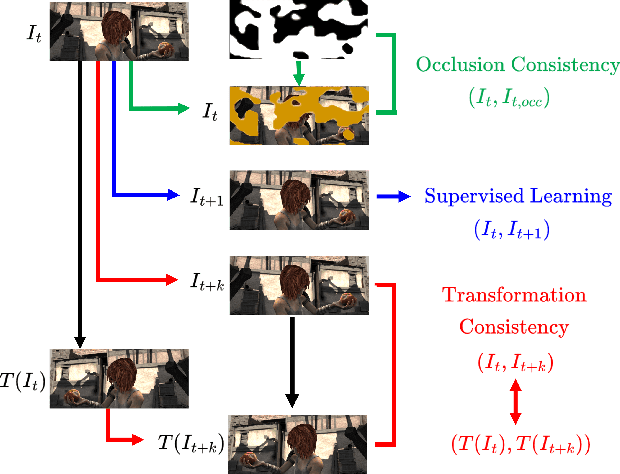
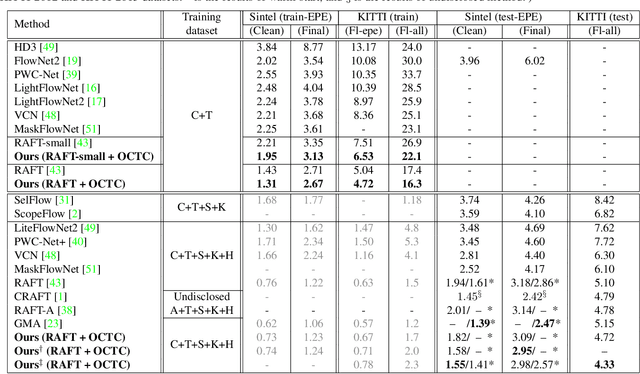
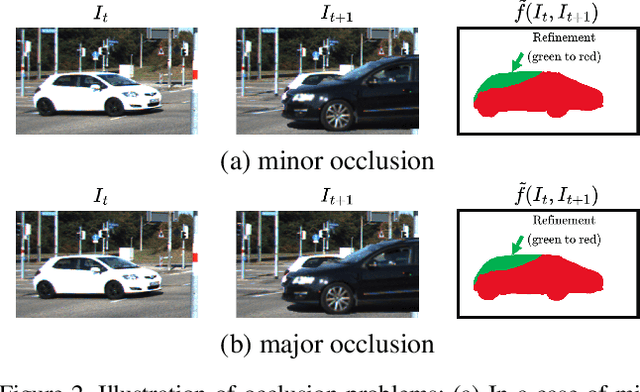

Abstract:Imposing consistency through proxy tasks has been shown to enhance data-driven learning and enable self-supervision in various tasks. This paper introduces novel and effective consistency strategies for optical flow estimation, a problem where labels from real-world data are very challenging to derive. More specifically, we propose occlusion consistency and zero forcing in the forms of self-supervised learning and transformation consistency in the form of semi-supervised learning. We apply these consistency techniques in a way that the network model learns to describe pixel-level motions better while requiring no additional annotations. We demonstrate that our consistency strategies applied to a strong baseline network model using the original datasets and labels provide further improvements, attaining the state-of-the-art results on the KITTI-2015 scene flow benchmark in the non-stereo category. Our method achieves the best foreground accuracy (4.33% in Fl-all) over both the stereo and non-stereo categories, even though using only monocular image inputs.
MUM : Mix Image Tiles and UnMix Feature Tiles for Semi-Supervised Object Detection
Nov 22, 2021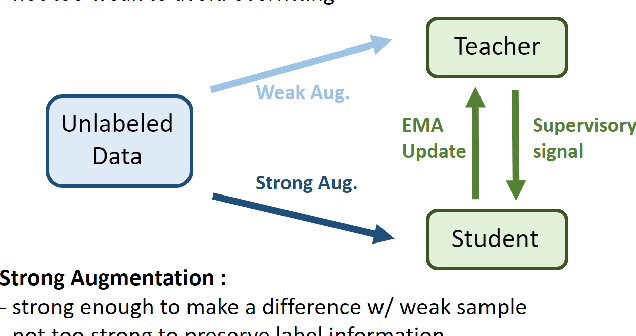

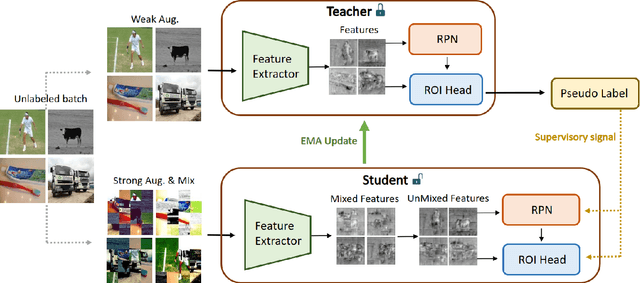
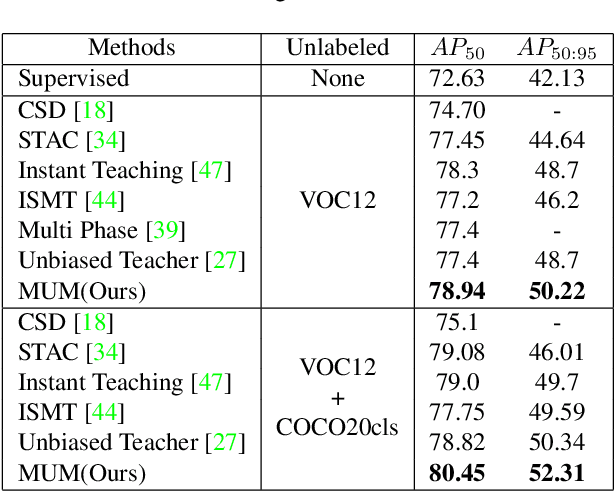
Abstract:Many recent semi-supervised learning (SSL) studies build teacher-student architecture and train the student network by the generated supervisory signal from the teacher. Data augmentation strategy plays a significant role in the SSL framework since it is hard to create a weak-strong augmented input pair without losing label information. Especially when extending SSL to semi-supervised object detection (SSOD), many strong augmentation methodologies related to image geometry and interpolation-regularization are hard to utilize since they possibly hurt the location information of the bounding box in the object detection task. To address this, we introduce a simple yet effective data augmentation method, Mix/UnMix (MUM), which unmixes feature tiles for the mixed image tiles for the SSOD framework. Our proposed method makes mixed input image tiles and reconstructs them in the feature space. Thus, MUM can enjoy the interpolation-regularization effect from non-interpolated pseudo-labels and successfully generate a meaningful weak-strong pair. Furthermore, MUM can be easily equipped on top of various SSOD methods. Extensive experiments on MS-COCO and PASCAL VOC datasets demonstrate the superiority of MUM by consistently improving the mAP performance over the baseline in all the tested SSOD benchmark protocols.
 Add to Chrome
Add to Chrome Add to Firefox
Add to Firefox Add to Edge
Add to Edge